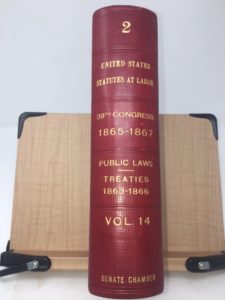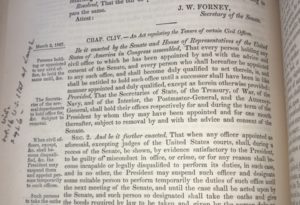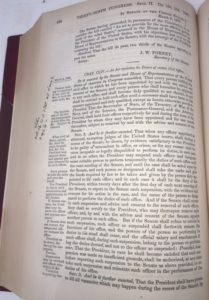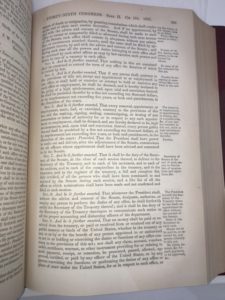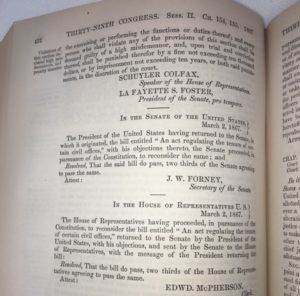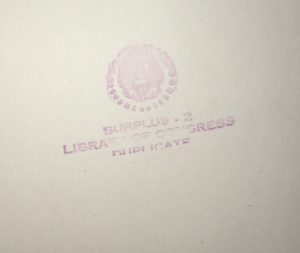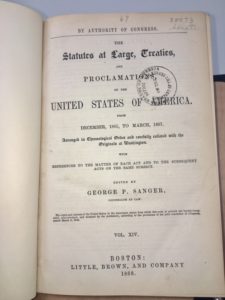TENURE IN OFFICE ACT OF 1867 – IMPEACHMENT OF JOHNSON
[39th Congress, Second Session, Chapter 154; 14 Stat. 430]
“An Act regulating the Tenure of certain Civil Offices”
The Tenure in Office Act prohibited the president from removing officials confirmed with the advice and consent of the Senate, unless the Senate approved their removal from office. Introduced by Senator Thaddeus Stevens, it was adopted on March 3, 1867, over President Andrew Johnson’s veto.
The Act was intended to protect members of President Johnson’s cabinet who disagreed with him over Reconstruction. In particular, the Act was an effort to shield Secretary of War Edwin Stanton, who was closely aligned with the Radical Republicans and their leader, Thaddeus Stevens.
In August of 1867, as anticipated, President Johnson tried to remove Secretary of War Stanton and replace him with General Ulysses Grant. After the Senate reconvened in 1868, it disapproved of Stanton’s removal, leading Grant to withdraw from consideration.
President Johnson next proceeded to appoint Adjutant General Lorenzo Thomas as Secretary of War, claiming that he wanted to create a case to test the Act before the Supreme Court. The House promptly proceeded to initiate the first ever impeachment proceedings against a United States President. The Senate trial began three days later and was presided over by Chief Justice Salmon P. Chase. After a three-month Senate trial, Johnson avoided conviction and removal from office by a single vote (one vote short of the 2/3 majority required for the Senate to convict). Importantly, the Johnson impeachment trial established the precedent that presidents should only be impeached for criminal acts, not merely for political disagreements.
Of the eleven articles of impeachment, nine were based on Johnson’s removal of Stanton. Article 5, for example, explicitly accused Johnson of “conspiring to unlawfully curtail faithful execution of the Tenure of Office Act.”
Legally, the Tenure Act was ambiguous as to whether it protected appointees of a former president. Johnson was thus not incorrect to question whether the Act applied to insulate Stanton (who was a Lincoln appointee).
The Act was eventually repealed in 1887 after President Grover Cleveland challenged its constitutionality in a message to Congress. Cleveland asserted that the president had the sole power to independently remove presidential appointees. This outcome strengthened the independence of the executive branch.
Background: Following the Civil War, the country was torn over the pace and objectives of the reconstruction process. Should the South be punished as a vanquished enemy, or fully readmitted back into the union unconditionally? What civil rights should be extended to former slaves?
During the war, President Lincoln’s Proclamation of Amnesty and Reconstruction had outlined an accommodating path for southern states to rejoin the nation. Radical Republicans envisioned a slower readmission process that would disenfranchise ex-Confederates. In what would prove to be his last speech prior to being assassinated, Lincoln suggested that he favored suffrage for African Americans along with temporary military occupation of the South.
During the prior year, Lincoln had signaled his hope to reunify the country and heal the wounds of secession when he selected a Southern Democrat, Andrew Johnson as his Vice President. As Senator from Tennessee, Johnson had declined to resign from federal office when his state seceded. Johnson was one of the few Southern politicians who loyally continued to serve. Thus, with his selection of a Southern Democrat, Andrew Johnson, President Lincoln demonstrated his intent that the South be dealt with fairly and humanely after the war.
When Andrew Johnson became president following Lincoln’s assassination, the Radical Republicans did not want a Southerner to control reconstruction without guarantees for the freed slaves. This became particularly evident when Johnson voted the Freedmen’s Bureau Act, which provided for temporary aid to former slaves. Johnson’s willingness to allow the South quick readmission to the Union brought him into direct conflict with the Radical Republicans. Led by Thaddeus Stevens, the Radical Republicans disagreed with President Johnson who favored Southern autonomy when dealing with former slaves – resulting in oppressive “Black Codes” that severely limited bitterly fought freedom for the former slaves.
Text of the Tenure in Office Act
